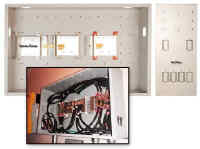The
Stream Engine employs a brushless, permanent magnet alternator
which is adjustable, enabling the user to match turbine output to the
electrical load. It has higher efficiency than previous alternators,
and is capable of outputs over 1 kilowatt (kW). All Stream
Engines are equipped with a rugged bronze turgo wheel,
universal nozzles (adaptable to sizing from 3 mm (1/8 inch) to 25 mm (1
inch), and a digital multimeter which is used to measure output
current. The entire system is made of non-corrosive alloys for long
life and durability. This machine can produce power from heads as low
as 2 metres (6 feet) to over 100 metres ( 300 feet).
 HOW IT WORKS: Water
is
collected upstream from the hydro and piped downstream to where the
turbine is located. As a rule the greater the head, the better (the
difference in elevation between the collection point and the turbine is
called the head). These small turbines are especially well suited to
produce usable power from springs and creeks that are too small to
sustain a conventional A.C. generating system. Because D.C. power can
be stored in batteries, these small systems operate 24 hours a day
collecting energy, a little at a time, to be delivered "on demand" from
the batteries as the need dictates.
HOW IT WORKS: Water
is
collected upstream from the hydro and piped downstream to where the
turbine is located. As a rule the greater the head, the better (the
difference in elevation between the collection point and the turbine is
called the head). These small turbines are especially well suited to
produce usable power from springs and creeks that are too small to
sustain a conventional A.C. generating system. Because D.C. power can
be stored in batteries, these small systems operate 24 hours a day
collecting energy, a little at a time, to be delivered "on demand" from
the batteries as the need dictates.
The typical American household consumes about 12 thousand watt hours
per day (not including electricity to power heating loads), or about
500 watts on average (though this can be reduced to about 300 watts or
even less, though careful conservation measures and by eliminating
waste).Turgo Runner - 18219 Bytes There are times, however, when as
much as 10,000 watts are needed, as when a refrigerator or well pum p is
started. An A.C. system cannot store energy and must be sized to meet
this peak demand, requiring up to 40 times as much water as a similarly
useful D.C. system. Smaller size saves money. A D.C. system is matched
to the average demand and extracts power the way that nature provides
it, slow and steady.
p is
started. An A.C. system cannot store energy and must be sized to meet
this peak demand, requiring up to 40 times as much water as a similarly
useful D.C. system. Smaller size saves money. A D.C. system is matched
to the average demand and extracts power the way that nature provides
it, slow and steady.
The Stream Engine
Personal Hydropower
Owner’s Manual
PDF (575k)
Installation Diagrams
 EcoVantage Mobile Catalog
EcoVantage Mobile Catalog




 HOW IT WORKS: Water
is
collected upstream from the hydro and piped downstream to where the
turbine is located. As a rule the greater the head, the better (the
difference in elevation between the collection point and the turbine is
called the head). These small turbines are especially well suited to
produce usable power from springs and creeks that are too small to
sustain a conventional A.C. generating system. Because D.C. power can
be stored in batteries, these small systems operate 24 hours a day
collecting energy, a little at a time, to be delivered "on demand" from
the batteries as the need dictates.
HOW IT WORKS: Water
is
collected upstream from the hydro and piped downstream to where the
turbine is located. As a rule the greater the head, the better (the
difference in elevation between the collection point and the turbine is
called the head). These small turbines are especially well suited to
produce usable power from springs and creeks that are too small to
sustain a conventional A.C. generating system. Because D.C. power can
be stored in batteries, these small systems operate 24 hours a day
collecting energy, a little at a time, to be delivered "on demand" from
the batteries as the need dictates. p is
started. An A.C. system cannot store energy and must be sized to meet
this peak demand, requiring up to 40 times as much water as a similarly
useful D.C. system. Smaller size saves money. A D.C. system is matched
to the average demand and extracts power the way that nature provides
it, slow and steady.
p is
started. An A.C. system cannot store energy and must be sized to meet
this peak demand, requiring up to 40 times as much water as a similarly
useful D.C. system. Smaller size saves money. A D.C. system is matched
to the average demand and extracts power the way that nature provides
it, slow and steady.